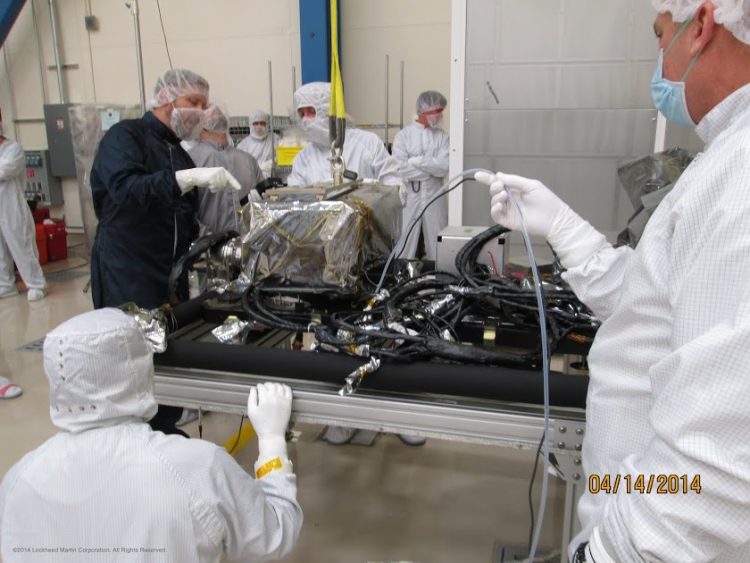Two GOES-R Instruments Complete Spacecraft Integration

The EXIS instrument is installed onto the sun pointing platform of the GOES-R spacecraft. Image Credit: Lockheed Martin
Two of the six instruments that will fly on NOAA's first Geostationary Operational Environmental Satellite – R (GOES-R) satellite have completed integration with the spacecraft. The Solar Ultraviolet Imager (SUVI) and Extreme Ultraviolet and X-ray Irradiance Sensors (EXIS) were installed on the sun-pointing platform. They will observe the sun and space weather, including coronal mass ejections, solar flares and ion fluxes that can disrupt power grids, communication and navigation systems and create radiation hazards.
“This development highlights the forward progress underway to complete the installation of the space weather instrument suite onto the GOES-R spacecraft,” said Pam Sullivan, GOES-R Flight Project Manager at NASA Goddard Space Flight Center, Greenbelt, Maryland. “It is critical we give our partners at NOAA’s Space Weather Prediction Center the tools they need to improve prediction capabilities and further our knowledge of space weather.”
Understanding Space Weather
The space weather mission is an important part of not only the overall GOES-R Series Program, but also NOAA’s National Weather Service (NWS), which is home to the Space Weather Prediction Center. Space weather describes the conditions in space that affect Earth and its technological systems. Space weather storms originate from the sun and occur in space near Earth or in the Earth's atmosphere.
Space weather can be difficult to understand since it is unlike the weather we experience here on Earth. For example, one type of space weather, known as coronal mass ejections, can have changing polarities, which can make it more challenging to predict the impacts of the magnetic storm. Watch here to learn more about how space weather impacts our everyday lives. To help kids understand space weather, the GOES-R Program partnered with NASA to create materials available here for students and teachers.
Installation of the SUVI and EXIS instruments moves the program another step closer to the launch of the GOES-R satellite in early 2016. In addition to SUVI and EXIS, the Advanced Baseline Imager (ABI) and the Space Environment In-Situ Suite (SEISS) were delivered for integration earlier this year and will be installed on the spacecraft in the coming months. The two remaining instruments that complete the GOES-R Series Program payload are the Magnetometer and Geostationary Lightning Mapper (GLM). Both instruments are scheduled for delivery later this year.
NOAA manages the GOES-R Series Program through an integrated NOAA-NASA office, staffed with personnel from both agencies and located at NASA’s Goddard Space Flight Center in Greenbelt, Maryland.
For more information about NOAA’s Satellite and Information Service visit:
Lauren Gaches/Rob Gutro
NOAA/NASA Goddard Space Flight Center
Media Contact
All latest news from the category: Physics and Astronomy
This area deals with the fundamental laws and building blocks of nature and how they interact, the properties and the behavior of matter, and research into space and time and their structures.
innovations-report provides in-depth reports and articles on subjects such as astrophysics, laser technologies, nuclear, quantum, particle and solid-state physics, nanotechnologies, planetary research and findings (Mars, Venus) and developments related to the Hubble Telescope.
Newest articles

Superradiant atoms could push the boundaries of how precisely time can be measured
Superradiant atoms can help us measure time more precisely than ever. In a new study, researchers from the University of Copenhagen present a new method for measuring the time interval,…

Ion thermoelectric conversion devices for near room temperature
The electrode sheet of the thermoelectric device consists of ionic hydrogel, which is sandwiched between the electrodes to form, and the Prussian blue on the electrode undergoes a redox reaction…

Zap Energy achieves 37-million-degree temperatures in a compact device
New publication reports record electron temperatures for a small-scale, sheared-flow-stabilized Z-pinch fusion device. In the nine decades since humans first produced fusion reactions, only a few fusion technologies have demonstrated…





















